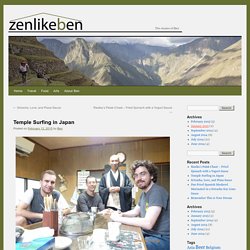

5 Apps That Offer The Best Meditation Advice. Temple Surfing in Japan. Sitting with Jiho, the head monk, and other guests at the Shōganji Zen Retreat in Oita, Japan When originally planning my trip to Japan I had wanted to stay in at least one temple while there.

The thought of waking up before the crack of dawn for a Buddhist sermon seemed both peaceful and poetic in some sort of way. I had heard that you could stay at various temples across Japan for not a lot of money. Turns out temples are no longer a popular place to stay among the Japanese themselves. Like Europeans with Catholicism, Japanese are slowly distancing themselves from Buddhism and Shintoism. Ninna-Ji in Kyoto, Japan The food at Omuro Kaikan, the dining hall of Ninna-ji, was simply amazing Temples in Japan are an inexpensive way to experience a entirely different culture and side of Japan. The meals at Nina-ji, for instance, was really, really good. The atmosphere at Ninna-ji was relaxing. The grounds at Nina-ji were beautiful. (More info on Staying at Ninna-ji here) Preparing for Meditation: Sitting Still. If you examine the meditation poses depicted in the world's great spiritual traditions, you'll find that they all have one thing in common — the unshakable stability of a mountain or tree.

Look at the kneeling pharaohs in the Egyptian pyramids, for example, or the cross-legged Buddhas in Indian caves or Japanese temples. They sit on a broad base that appears to be deeply rooted in the earth, and they have a grounded presence that says, "I can't be budged. I'm here to stay. " When you sit up straight like a mountain or a tree, your body acts as a link between heaven and earth — and by analogy, connects your physical, embodied existence with the sacred or spiritual dimension of being. In addition to the spiritual aspect, you might consider that sitting up straight confers some practical benefits as well. Of course, you can always lean against the wall — or so you may think. Figure 1: Position your buttocks a bit higher than your knees.
Figure 3: The Burmese position is good for beginners. 3 Meditation Techniques for Beginners. Gold stars to those who can make it through this article without wondering about dinner or unattended emails, mindlessly scrolling through Instagram or scanning half a page before realizing you have no idea what the heck you just read.

Amit Sood, author of the upcoming book "The Mayo Clinic Guide to Stress-Free Living," calls this autopilot daze, in which we're physically here, but mentally elsewhere – our "default mode. " And it's not a great place to be. We spend about half of our day in default mode, in which we're typically unhappy, he says, adding that too much time in this mode can lead to increased risk of depression, anxiety and attention deficit.
Our brain's counter to default mode is its focus mode. Imagine if, as you were reading, a giraffe walked up to you. We may not want a police car (or a giraffe) following us, but it is helpful to engage that focused attention these experiences beckon. 3 Easy Beginner Meditation Techniques. Everybody wants a long life full of vitality.

But beyond the basics of good diet and exercise, what can you do? For more than 2,000 years, Chinese medicine has refined the use of meditation to build the body's life force. And the scientists agree. The well-documented effects of regular meditation include lowered blood pressure, less heart disease, decreased chronic pain, and increased mental clarity. Meditation is an indispensable tool for living a longer, richer life and avoiding the burnout that comes from constant stress. Meditation How-ToMany people find the idea of meditation to be daunting. Practice meditation in a quiet environment. Sit comfortably in a chair with your spine erect and both legs and thighs forming a ninety-degree angle with the ground, keeping your feet at shoulder width apart.
Start by breathing as naturally as possible. Begin to quiet your mind. 1. Sit comfortably or lie down on your back. Start on top of your head. Start from the temples of your head. UCLA Mindful Awareness Research Center.